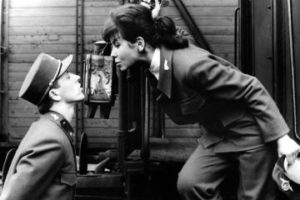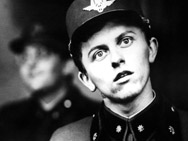On Rewatching Closely Watched Trains
The Roxy
In 1966, the now-famous Barrandov Studios in Prague released a bombshell of a movie entitled “Closely Watched Trains” directed by a young Czech new wave auteur, Jiri Menzel. It was based on a 1965 novel by Bohumil Hrabal, an author who would become one of the last century’s most prolific Czech storytellers. The movie was released in the United States in New York in 1967, with English subtitles. As happened in those days it would take a year for the movie to trickle down to the provinces, or at least those small American towns with “art house” theaters. In early 1968, it won an Academy Award. The movie landed in one cow town after another, but one in particular, known to be overgrown with tumbleweed (call it “hick” or call it “with-it”)—Albuquerque, New Mexico.
Ah but yes! And what luck to have friends who knew all about it! At age seventeen, to worship at the seedy, hip and alluring Roxy Theater was my week’s highest calling! In truth, that tiny fire-hazard of a movie house was only a small part of my artistic and intellectual flowering, but it was where I had been going for many a weekend that spring—or rather I should say giddily accompanied by friends for the latter half of my senior year in high school. We swooned together in the chapel of cinema, engrossed in such wonders as the “Friday Night Underground” (independent shorts shown at 12 midnight on Fridays); any number of Ingmar Bergman’s dark visions of humanity (“The Seventh Seal”); or maybe the latest of “late” Warhol—I must confess, “Lonesome Cowboys” is the one Warhol I actually remember, for a night of tedium unmatched by any other.
Still, while the Roxy could be crass and vulgar—where “I am Curious Yellow” was first screened in our town—it was ours, after all! All ours.
Sweet Roxy!
I bow to your marquee, shameless
I kiss your silver screen, curtain-less
Your pews were but torn velveteen
Your one central nave a scene
Like no other—a stained, tattered mess
Strewn with counting beads of spilled popcorn
—but for all this,
you were our ancient holy ground
The often harassed little theater was sometimes even shuttered by the local police, as was the Yale Street Grasshopper for selling Henry Miller to the underage among us. But the high priests of carnal culture carried on thanks to a few local attorneys and a series of Supreme Court rulings on such poisonous things as free speech and obscenity from the late 50s and early 60s. Who remembers now that even “Lady Chatterley’s Lover” was contraband in most communities?
A minor point perhaps. But for a brief time in my life the Roxy to us was no less than a frickin’ church. Standing on Central Ave, we sneered at the status quo as we stood in line at the box office. It was our local version of Allen Ginsburg, sticking its depraved middle finger into the eye of the bourgeoisie. We were, admittedly, selective—not particularly discreet—indifferent to the skin flicks—worshiping the new cinema—or as my friends called them, the flicks.
Jiri Menzel “Closely Watched Trains” (1967)
 If the Roxy was my church, their movies were my baptism. Over the years I always remembered the scenes from “Closely” that changed my life. The darkly comic black-and-white images stayed with me, though to be sure, less and less through the years. As decades passed I might be visited by a long-ago memory of that movie on a dreary day that matched the overcast oppression of the village where it was filmed. Or I might experience one of those instantaneous, momentary time warps whereby we relive, briefly, some intense feeling from the picture itself: a murderous humiliation, a bittersweet love, a lyrical depression.
If the Roxy was my church, their movies were my baptism. Over the years I always remembered the scenes from “Closely” that changed my life. The darkly comic black-and-white images stayed with me, though to be sure, less and less through the years. As decades passed I might be visited by a long-ago memory of that movie on a dreary day that matched the overcast oppression of the village where it was filmed. Or I might experience one of those instantaneous, momentary time warps whereby we relive, briefly, some intense feeling from the picture itself: a murderous humiliation, a bittersweet love, a lyrical depression.
As with other “lost” movies, I always wanted very much to see it again. In the 70’s and 80’s it was not “brought back” to the repertory movie houses of the time. In the 90’s the movie could not be found at Blockbuster. I thought maybe one day it would show at our local museum, or a college theater nearby. Hoping so, I would check the listings. But no, not to happen. Never to happen.
This year—something about turning 65?—I felt I had to go find it. The memories sought me out. I took another shot after years of nostalgia-neglect. But find it I did. On Hulu, of all places. Which is in some small way apropos. For the pitiful Hulu is, if you will, a kind of Roxy of the modern world—a low-end provider of bad television shows and “B” movies, instant video panderer much the same as the scabrous Roxy was a low-brow provider of titillating European sex movies. Yet both institutions have (and had) their quiet little unsung “art category,” their hidden little space in the “art house” universe. As it happens Hulu provides a select number of movies from the (let us pause with effect) “Criterion Collection” – really a video sales and on demand service which oddly has not nearly enough of everything. Suffice it to say that on Hulu you can catch “Closely Watched Trains” again (or, for the first time, if you didn’t catch it back in the day)—but PLEASE don’t hold me accountable if you forget to cancel your free “trial subscription” immediately afterwards.

Vaclav Neckar as Miloš
If you watch contemporary East European or even middle-eastern art movies as I still do now, you may be thinking what was so special about “Closely”. The film is even better than I remembered it. Black and white, set in a train station in a small provincial town during the war with the Nazis—a station populated by a stupid, obese and incompetent station master and his wife, and a sex-starved train dispatcher, and also the little hero of the movie, Miloš Hrma, (pronounced “Miloshi”) who is the train dispatcher’s apprentice. He is a boy in search of a girlfriend. To whom he can show his manhood. Alas things do not go well for Miloš. Well, they don’t and then they do, and then a series of events, rather more glimpses of life in the little town, lead to a gradual dreadful perception that something bigger and crazier is about to happen. A beautiful woman shows up. A “partisan”. She hands over a package. She dispatcher ends up being tried by the mayor, a Nazi collaborator, over a sexual encounter with an underage girl. And so at the end Miloš must take over for him.
I had never seen anything like it. Could movies really be this good? It was the beginning of my love affair with cinema. I always remembered the little town and its little train station and its overcast gray and snowy landscape. Haunting me all these many years with images . . . . By the time I had seen this film, I had devoured “Madame Bovary” and “Crime and Punishment” and what Flaubert and Dostoyevsky held out for me were no more mesmerizing and absolutely revolutionary as this film was. On a par with the era’s best tragicomedies, of which there are far fewer today . . . Truffaut’s “The 400 Blows” . . . de Broca’s “The King of Hearts”—hell, even the fat boys at Rotten Tomatoes give “Closely” a 100% rating. Not sure why it has been overlooked for so long.
Herewith, a link to the original NYT movie review when the movie first made its American debut. Worth a look. As noted in the review, the term “Closely Watched Trains” was actually the official designation of secret Nazi munitions shipments making their way south through the occupied Czechoslovakian hinterlands.
A Note on Availability (6/10/2020)
Since the writing of this blog post, “Closely Watched Trains” is again available for streaming on the Criterion Channel.
Leave a Reply